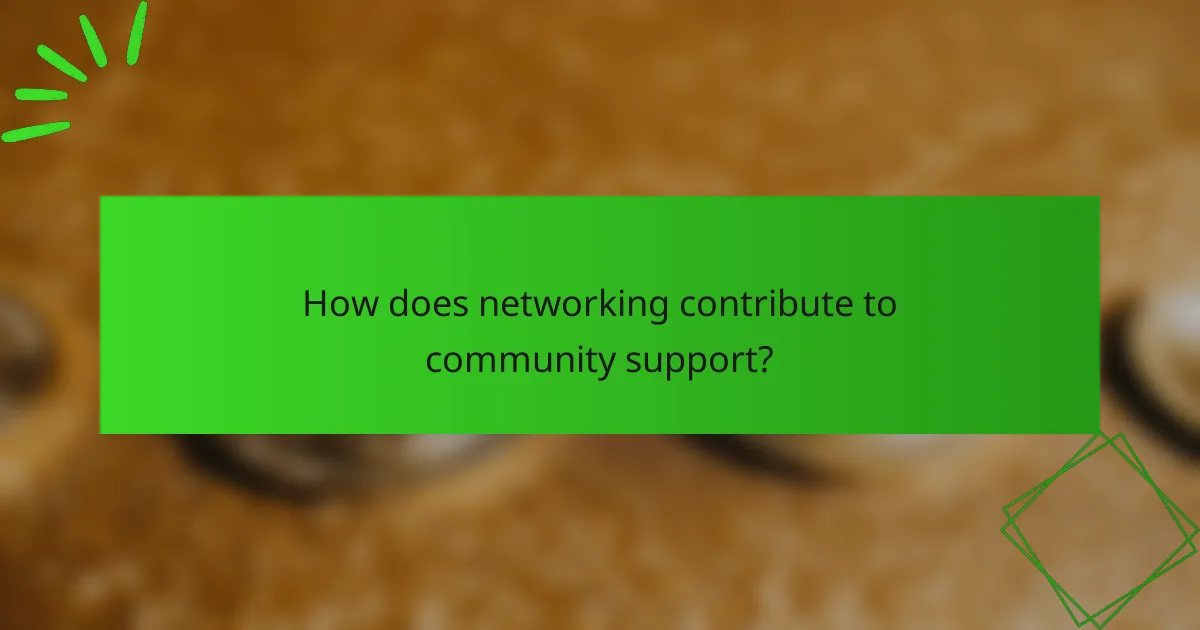Community support is essential for enhancing engagement and building strong connections among residents. By providing access to valuable resources and fostering networking opportunities, communities can collaborate effectively and create a vibrant environment that benefits everyone involved.

How can community support enhance engagement in Canada?
Community support in Canada can significantly boost engagement by fostering connections among residents and providing access to shared resources. This collaborative environment encourages participation and strengthens social ties, leading to a more vibrant community life.
Increased participation through local events
Local events such as festivals, workshops, and volunteer opportunities can drive higher participation rates within communities. These gatherings not only provide entertainment but also create spaces for residents to meet and collaborate on common interests.
To maximize engagement, consider organizing events that cater to diverse age groups and interests, such as family-friendly activities or cultural celebrations. Promoting these events through local channels, like community boards and social media, can further enhance attendance.
Online forums for continuous interaction
Online forums serve as platforms for ongoing dialogue among community members, allowing for continuous interaction beyond physical events. These digital spaces enable individuals to share ideas, ask questions, and offer support at their convenience.
Utilizing popular platforms like Facebook Groups or dedicated community websites can help maintain engagement. Ensure that these forums are moderated to foster a respectful environment and encourage active participation through regular discussions or themed topics.
Collaborative projects with local organizations
Partnering with local organizations for collaborative projects can amplify community support and engagement. These initiatives often address specific needs, such as environmental clean-ups or educational programs, and can attract a wider audience.
When planning these projects, identify organizations that align with community values and goals. Clear communication about project objectives and volunteer opportunities can motivate residents to get involved and contribute their skills.

What resources are available for community support?
Community support resources include government grants, non-profit organizations, and digital platforms that facilitate engagement and resource sharing. These resources help communities access funding, training, and tools necessary for effective initiatives.
Government grants for community initiatives
Government grants are financial awards provided to support specific community projects or initiatives. These grants can vary widely in amount, often ranging from a few thousand to several million dollars, depending on the project scope and funding source.
To apply for government grants, communities typically need to submit a detailed proposal outlining their project goals, budget, and expected outcomes. It’s essential to adhere to application guidelines and deadlines to increase the chances of securing funding.
Non-profit organizations providing tools and training
Non-profit organizations play a crucial role in offering tools and training for community development. They often provide workshops, resources, and mentorship programs designed to empower community leaders and volunteers.
Examples of such organizations include local community foundations and national entities like the United Way. Engaging with these organizations can help communities build capacity and enhance their effectiveness in addressing local issues.
Digital platforms for resource sharing
Digital platforms facilitate resource sharing among community members, allowing for collaboration and information exchange. Websites and apps like Nextdoor, Facebook Groups, and local forums enable residents to share resources, organize events, and support one another.
Utilizing these platforms effectively requires clear communication and active participation. Communities should encourage members to contribute and share relevant information to maximize the benefits of these digital tools.

How does networking contribute to community support?
Networking plays a crucial role in community support by fostering relationships that enhance collaboration and resource sharing. It allows individuals and organizations to connect, share knowledge, and mobilize efforts towards common goals, ultimately strengthening the community as a whole.
Building connections through social media
Social media platforms are vital tools for building connections within a community. They enable users to engage with one another, share resources, and promote events, making it easier to mobilize support for various initiatives. Utilizing platforms like Facebook, Twitter, and LinkedIn can help individuals expand their networks and stay informed about local opportunities.
To maximize the benefits of social media, consider joining local groups or forums that align with your interests. Actively participating in discussions and sharing relevant content can enhance visibility and foster meaningful connections.
Networking events in major Canadian cities
Networking events in cities like Toronto, Vancouver, and Montreal provide excellent opportunities for community members to meet face-to-face. These gatherings often include workshops, seminars, and informal meetups where participants can exchange ideas and resources. Attending such events can significantly broaden your network and introduce you to potential collaborators.
Look for events hosted by local organizations or community centers, which often cater to specific interests or industries. Regular attendance can help you stay connected and informed about community needs and initiatives.
Partnerships with local businesses
Forming partnerships with local businesses can enhance community support by pooling resources and expertise. Businesses often have access to funding, venues, and promotional channels that can benefit community initiatives. Establishing these partnerships can lead to mutually beneficial relationships that strengthen both the business and the community.
When seeking partnerships, approach businesses that align with your community goals. Propose clear benefits for both parties, such as co-hosting events or sponsoring community projects, to create a compelling case for collaboration.

What are the best practices for engaging with community support?
Engaging with community support effectively involves actively listening to members, fostering inclusivity, and providing up-to-date resources. These practices help build trust and encourage participation, ultimately strengthening the community.
Utilizing feedback for improvement
Collecting and analyzing feedback is crucial for enhancing community support. Use surveys, suggestion boxes, or regular check-ins to gather insights from members about their experiences and needs. This information can guide adjustments to programs and services.
Implement a system for tracking feedback over time to identify trends and areas for growth. Regularly share updates on how feedback has influenced changes to reinforce that member input is valued.
Creating inclusive spaces for all members
Inclusivity is essential for a thriving community. Ensure that all members feel welcome by promoting diverse perspectives and addressing barriers to participation. This can include providing materials in multiple languages or ensuring physical spaces are accessible.
Encourage participation from underrepresented groups by hosting events that cater to their interests and needs. Creating a culture of respect and understanding fosters a sense of belonging among all members.
Regularly updating community resources
Keeping community resources current is vital for maintaining engagement. Regularly review and refresh information on available support services, events, and educational materials. This ensures members have access to the latest and most relevant resources.
Consider setting a schedule for updates, such as quarterly reviews, and involve community members in the process to ensure the resources meet their needs. Highlight new resources in newsletters or community meetings to keep everyone informed.

What are the key criteria for selecting community support platforms?
When selecting community support platforms, prioritize user-friendliness, local resource availability, and integration capabilities with existing tools. These criteria ensure that the platform meets the needs of users and enhances community engagement effectively.
User-friendly interface
A user-friendly interface is crucial for encouraging engagement within a community support platform. It should be intuitive, allowing users to navigate easily without extensive training. Consider platforms that offer customizable dashboards and clear navigation paths.
Look for features such as drag-and-drop functionality, mobile compatibility, and accessible design for users with disabilities. These elements can significantly enhance user experience and participation.
Availability of local resources
Local resources are essential for community support platforms to effectively address specific needs. Platforms should provide access to regional services, local events, and relevant information tailored to the community’s context.
Check if the platform includes directories of local organizations, support groups, or government services. This localized approach fosters stronger connections and ensures users can find the help they need within their immediate environment.
Integration with existing tools
Integration with existing tools is vital for streamlining workflows and enhancing productivity. A good community support platform should easily connect with tools like email services, project management software, and social media platforms.
Evaluate the platform’s compatibility with commonly used applications in your community. This can reduce redundancy and improve communication, making it easier for users to access all necessary resources in one place.

How can digital products facilitate community support?
Digital products enhance community support by providing accessible platforms for engagement, resource sharing, and networking. They enable individuals to connect, learn, and collaborate effectively, regardless of geographical barriers.
Online courses for skill development
Online courses serve as a vital resource for community members looking to enhance their skills. These courses can cover a wide range of topics, from technical skills like coding to soft skills such as communication and leadership. Platforms like Coursera, Udemy, and local initiatives often offer these courses at various price points, including free options.
When selecting an online course, consider factors such as course content, instructor credentials, and user reviews. Look for courses that provide practical assignments or projects to apply what you learn. Additionally, many platforms offer community forums where learners can interact, ask questions, and share insights, further enriching the learning experience.
To maximize the benefits of online courses, set specific learning goals and allocate regular time for study. Avoid common pitfalls like enrolling in too many courses at once, which can lead to overwhelm and incomplete learning. Instead, focus on one or two courses that align closely with your community’s needs and your personal development goals.










